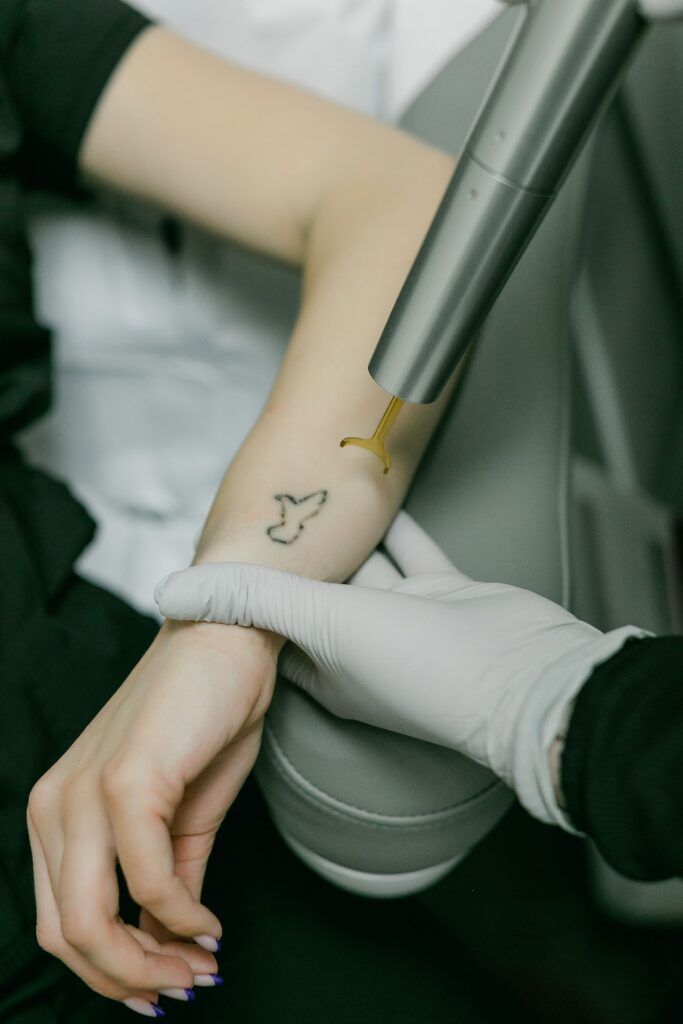
PicoWay Laser at Toronto’s Philosophy of Beauty is the most advanced tattoo removal technology we have. It delivers gorgeous results with far less discomfort and fewer treatments than ever.
PicoWay for melasma is also the new standard for facial skin tone balance thanks to its precision pigment targeting and skin safety.
If you’re tired of dealing with unwanted skin pigmentation irregularities, or you’ve got some body ink you’d rather erase, we have good news for you! Pico laser technology has changed the game and made tattoo removal or removing dark spots easier than ever. Let us show you why we’re impressed with the PicoWay Laser at Philosophy of Beauty in Toronto.
Tattoos are considered mainstream today. Toronto tattoo removal patients are also on the rise! That may be due to poorly done body art, or merely outgrowing images that seemed appealing years before. Regardless of the reason for seeking removal, tattoo ink can be challenging to erase.
Many years ago, painful dermabrasion was used to sand away the top layers of skin to remove ink. Needless to say, this uncomfortable process didn’t yield clear, healthy skin in most cases, and it wasn’t a pleasant prospect for most people. Q-switched lasers came on the scene in the 1990s, with good results achieved after 10-14 treatments in many cases.
The aim of tattoo removal laser technology over the years since has been to reduce non-selective tissue targeting and more effectively break apart ink particles to be safely flushed from the system. Precise ink particle targeting means reducing risks of thermal damage to surface skin, and the resulting scars.
PicoWay now allows better tattoo removal results in less time than Q-switched modalities, without the discomfort and with fewer treatment sessions.
Fitzpatrick skin types I-VI can now see impressive ink removal results for all colours – red, orange, white, green, blue, purple and black ink.
People who search online for PicoWay Laser tattoo removal or melasma treatment often wonder why this device is more effective.
The critical difference in pico-laser precision is pulse speed.
Nanosecond pulses are one billionth of a second, and picosecond pulses are one-trillionth. That all sounds very fast, of course, but Pico is 1000 times faster.
PicoWay even delivers 4.5 times the photoacoustic power than other top picosecond lasers. When it comes to targeting & disintegrating ink particles under the skin, a combination of lightning-fast pulse energy plus short pulse duration creates dust out of the particles and limits surrounding tissue damage. Both thermal and photoacoustic energy smash apart the ink particles.
Previous modalities were only able to break up the ink into relatively large pieces, which allowed for some removal but left particles remaining with each pass. The requirement for multiple passes and less effective thermal energy targeting could lead to diffused skin damage, burns and sometimes scars.
These rapid pulse wavelengths penetrate 1 to 4 millimetres into skin for selective photothermolysis and deliver photoacoustic shockwaves that obliterate ink particles and melanocytes. That “ink debris” is carried away from your tissue through the body’s natural waste elimination system and lymphatic drainage.
Many people have challenging ink and deep pigments that were nearly impossible to remove in the past. Those patients once needed to resort to aggressive or invasive techniques, or simply cover up unwanted art with additional tattoos. Now, Pico laser technology offers and more satisfying option for deep, challenging ink.
Depending on the type of tattoo you have, your individual recommended removal session may vary according to the following guidelines:
- Professional tattoo removal- 3 to 6 PicoWay sessions
- Amateur tattoo removal- 2 to 3 PicoWay sessions
- Cosmetic (permanent makeup removal)- 1 to 3 PicoWay sessions
- Traumatic tattoos resulting from injuries- 2 to 3 PicoWay sessions
Medical lesion/melanin removal – 2 to 3 PicoWay sessions
Visiting Philosophy of Beauty for your consultation and skin assessment begins with sharing your goals, concerns and an exam of your focus area. You’ll be provided with detailed information about laser tattoo removal- the process, recovery and results.
Depending on the type/location/colour and age of your tattoo, different treatment options may be recommended.
To see optimal pigment clearance, multiple treatment sessions are usually advised. Especially in the case of tattoo removal, just a few, or several sessions spaced 2-8 weeks apart can be suggested based on clinical judgement.
Because PicoWay uses ultra-short laser pulses, the result is a laser that requires minimal, or no downtime. Our patients resume their normal activities and apply makeup within one day of treatment. Thanks to that rapid picosecond pulse technology, we avoid heating the skin with photothermal (heat) energy and bypass common side effects like pain or scarring.
Your Philosophy of Beauty laser technician will discuss your needs and concerns in your private treatment suite. You’ll have a topical numbing medication applied to the treatment area, which helps dull sensation and keeps you comfortable.
We also use a cold air device to soothe the treatment area further and help you enjoy the process. Most people describe the laser energy as snapping/prickly during their session, but tolerable.
Normal expectations for immediate post-treatment skin changes:
- You may notice a white-gray discoloration on your treated skin for a few minutes, or even lasting a few days.
- Rarely, a scab may form and fall off within 7-10 days
- We’ll apply a non-stick, light dressing over your treatment area, which can be removed after 12 hours.
We’ll ask you to prevent trauma/friction to the sensitive area for 7-10 days.
PicoWay is well known as a leader in tattoo and pigment removal, but it’s also the newest generation of effective laser technology for melasma treatment in Toronto. It’s also a powerful device used to reduce acne scars and even wrinkles.
Acne Scar Treatment
Nearly half of adults complain about some degree of acne scarring. Many facial scars are pigmented, and some create textural irregularities where tissue and collagen loss occurred in the skin. PicoWay reaches below the skin’s surface to stimulate collagen and elastin production. Patients are typically delighted with this treatment & note dramatic improvements in skin texture and tone.
Wrinkle Treatment
Wrinkles often result from loss of collagen and elastin in our skin. Over the age of 30, these changes can develop rapidly for some people.
PicoWay is non-invasive and uses Pico laser pulses to stimulate collagenisis in deep skin layers, without harming the surface.
Sun Spots/Age Spots
Dark spots, also known as benign pigmented lesions, can vary between people, but often appear with age and depending on sunlight exposure. Café-au-lait (brown patches), and melasma tend to cover larger areas and may be triggered by hormone changes, or worsened by sun exposure.
Many people feel self-conscious when dealing with severe facial pigmentation issues that don’t respond to topical creams and can’t be covered well with makeup. PicoWay is designed to target just the pigment while protecting surrounding cells. It’s practical and fast melasma treatment and works very well for various facial blemishes.
You’re invited to meet with our skin specialists and consider whether PicoWay Laser treatment could help you reveal even-toned skin you love.
Philosophy of Beauty is pleased to offer our clients some of the world’s leading laser systems. We’d love to help you reveal a brighter look and clear away unwanted ink. Your consultation is free, and we welcome your questions about PicoWay or other laser treatments.
Please call or write, and we’ll book an appointment that’s convenient for you. See you soon!
Disclaimer: Similar and/or permanent results, are not guaranteed based on the treatment/procedure and may vary from patient to patient, based on multiple factors, including genetics and lifestyle of each patient. View full disclaimer.
